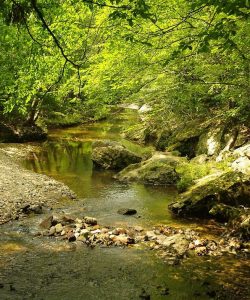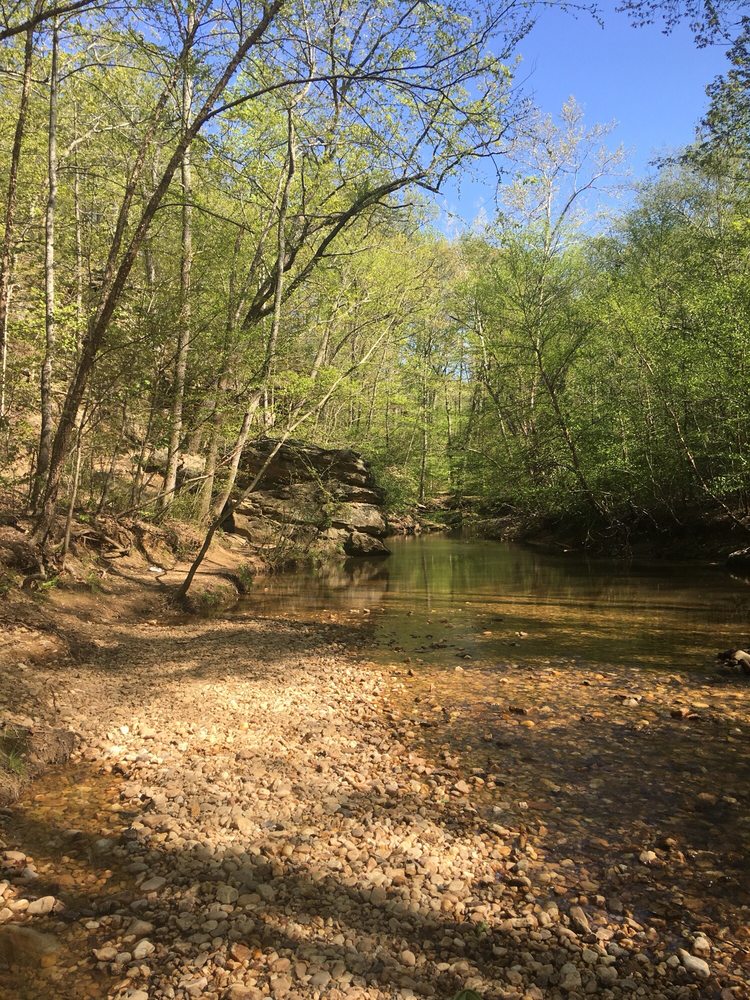Experience salt water droplets and have the privilege of walking the trails outlined by centuries upon centuries of history at Alum Spring Park, a 34-acre woodland retreat located off Greenbriar Drive. Spanning 40 feet in height and ample 400 feet in length, Alum Spring Rock is one of its most majestic features – a testimony to enduring geological formations that date back 100 million years.
Alum Spring Park is a magnificent 34-acre woodland retreat, located off Greenbriar Drive. Complete with a playground, hiking trails, and the awe-inspiring Alum Spring Rock, which towers 40 feet high and stretches 400 feet in length. Not only is it a beautiful nature spot, but also one of Fredericksburg’s most historic sites. People have been visiting this area for centuries and it has played an important role in the area’s history. Even George Washington’s birth year saw Colonel William Byrd of Westover visiting Fredericksburg and writing about the powerful alum spring and its ability to aid those suffering from dropsy.
The Alum Power
The water flow was much greater in those days, but a layer of pink, white, or yellow alum still seeps from under the cliff and deposits on the ground. Alum has numerous uses – from the production of medicines, textiles, sugar, paper, paints, matches, deodorants, and baking powder, to water purification and for waterproofing paper. It is even found in vintage pickle recipes! Historically, people have believed that alum spring water has curative powers, and many have flocked to these springs in Virginia, such as Rockbridge Alum and Bath Alum. John H. Buis once tried to turn the Fredericksburg spring into a health resort, which he extolled in a letter to The Free Lance newspaper. Although nothing came of his idea, Alum Spring Park continues to be an amazing oasis of beauty and history today.

Alum Spring Sandstone Cliff
The Alum Spring sandstone cliff is an awe-inspiring geological formation that is a testament to time with its age of over 100 million years. During the days of dinosaurs, waters flowing from the western mountains towards the newly-formed Atlantic Ocean carried sediment that composed the present-day sandstone. George Washington surveyed the Alum Spring property for his brother-in-law, Fielding Lewis of Kenmore, who was the first in a series of individuals to operate a mill at Alum Spring. Buildings at Alum Spring were used as a prison during the Revolutionary War, housing Hessian and British troops captured at Trenton, New Jersey, by George Washington. After the surrender of Cornwallis, the buildings were also used as a hospital with Dr. Charles Mortimer, the first mayor of Fredericksburg and physician to George Washington’s mother Mary, treating the sick there with assistance from Dr. John Julien. By the 19th century, the Alum Spring property had become a bustling area with William B. Stuart operating a water grist flour mill and sawmill in 1809-10, and Samuel Alsop managing what was termed “the Alum Spring Mill” by June of 1831. In the early 1900s, the millstones from the old Alum Spring mill were sold to artist Gari Melchers and taken across the Rappahannock River to the Melchers’ home, Belmont.
The Value of Alum Spring Millpond
The Alum Spring millpond was an invaluable resource, as evidenced by the 1853 report from the Fredericksburg News that it provided “cool water, mint juleps, and ice cream” to summer lovers. Further testament to its worth is found in advertisements for pure ice from the spring by local merchants Martha R. Cooke in 1831, John Ferneyhough in 1838, and W. S. Chesley in 1860. The trail in Alum Spring Park marks the site of a former ice house, allowing visitors to explore this important part of history in person.
Tragic Duel Between Cousins
The rivalry between cousins William Thornton and Francis Fitzhugh Conway was taken to a new level when they each expressed their admiration for Miss Nellie Madison, a guest at the Chatham festivities. As Francis had adorned his horse with a new, impressive bridle, he made veiled references to a surprise he would reveal later that night. Unbeknownst to him, however, the groom had switched the bridles on the horses, leading to William’s horse making a greater impression on Miss Nellie. This resulted in an escalating argument which ultimately led to a challenge of a pistol duel. At the word ‘fire’, both shots were fired simultaneously and each bullet passed through the region of the bladder in each combatant, leading to the tragic death of both men. Their story is commemorated by the Virginia Herald’s notice of a pair of brass-barreled pistols found near the Alum Spring, which could be claimed from William or John Rutter.
History of the Narrow Gauge Railroad
The Potomac, Fredericksburg, and Piedmont, more commonly known as the Narrow Gauge Railroad, was constructed in the 1850s on the Alum Spring property. Despite disruptions caused by the Civil War, the track was finished in 1870 and quickly gained the nickname “Poor Folks and Preachers” due to its chief clientele. In 1877, the railroad celebrated its inaugural journey from Fredericksburg to Orange County Courthouse. After a notable wreck at Alum Spring in 1920, the railroad was rechristened the Virginia Central and converted to a standard track. On January 1st, 1938 it made its final trip to Orange County, marking the end of an era for this remarkable railroad line.
The Shadow of the Cliff
The Shadows of the Cliff provided a haven for hundreds of women and children during the ravages of war in December 1862. St. Mary’s Catholic Church held a popular picnic at Alum Spring in June 1871, giving locals a much-needed sense of peace. In the 1920s, Hazel Run’s deep pool was a favorite swimming destination for local boys who affectionately named it Fat Annie’s Swimming Hole after their neighbor’s repeated attempts to chase them away. Although swimming is no longer allowed in the area, its history remains a reminder of the courage and resilience of the Fredericksburg locals.
The ravages of war left its mark on the city of Fredericksburg in December 1862, yet the sandstone cliff provided a haven for hundreds of women and children. The shadows of the cliff served to bring a sense of peace to the area, even hosting Confederate reunions in 1885 and 1886. St. Mary’s Catholic Church held a picnic at Alum Spring in June 1871 which quickly became a popular spot for local ladies to entertain.
In the 1920s, Hazel Run’s deep pool upstream from the cliff area was a favorite swimming destination for local boys – much to the displeasure of the large lady living nearby, Annie. Despite her repeated attempts to chase them away, the boys kept coming back and eventually named the pool after her in their affectionate way: Fat Annie’s Swimming Hole. Although swimming is no longer allowed in the area, it remains a testament to the courage and resilience of the locals.
The Resilience of Alum Spring Park
Alum Spring Park is a testament to the resilience of Fredericksburg, having proudly endured both an earthquake and a hurricane. On October 9th, 1885, the quake shook the city and sent a large chunk of rock down into Hazel Run below. Then in September 2003, Hurricane Isabel made her presence known, leaving significant damage in her wake. Fortunately, the park will be receiving new playground equipment in the winter of 2005, allowing it to become even more of a beloved recreational area for the local community.
Saving Alum Spring
Robert A. Hodge: A Legacy of Conservation
Robert A. Hodge was an esteemed historian and teacher whose efforts to preserve Alum Spring in Fredericksburg, Virginia, left a lasting legacy. He was renowned for his commitment to researching the area’s history, having indexed local newspapers and mapped historic cemeteries. Furthermore, he was loved by his students as a professor at James Monroe High School, using Alum Spring as an outdoor laboratory for his biology lessons. There, they observed fossilized wood, sandstone cliffs with crystallized alum, a stream bed with quartz and jasper, and other diverse plant and animal life. Through his tireless work, Robert A. Hodge ensured that Alum Spring would remain a public park for future generations to enjoy.
Thanks to his tireless work, Alum Spring Park now features playground equipment, charcoal grills, picnic tables, improved and marked walking trails, and a rustic footbridge spanning Hazel Run. Visitors are invited to explore the park year-round from dawn to dusk; for further information on visiting, call Fredericksburg Parks and Recreation at 540-372-1086, or check their website.
Alum Spring Park is a natural and historic wonder near Fredericksburg which offers an opportunity for visitors to explore the outdoors while specifically taking account of local history. From health properties noted in colonial days to Colonel William Byrd’s praises in 1732, this park is evocative of times past and well as offering plenty of outdoor activities for people of all ages. With the impressive sandstone that towers 40 feet high like nothing else in the area giving considerable weight in today’s modern world, this location retains the invaluable ideas of our past with each layer characterizing it in an emotional weight in a manner greater than some bulky novels. Undoubtedly a timeless experience, Alum Spring Park is well worth a look.





